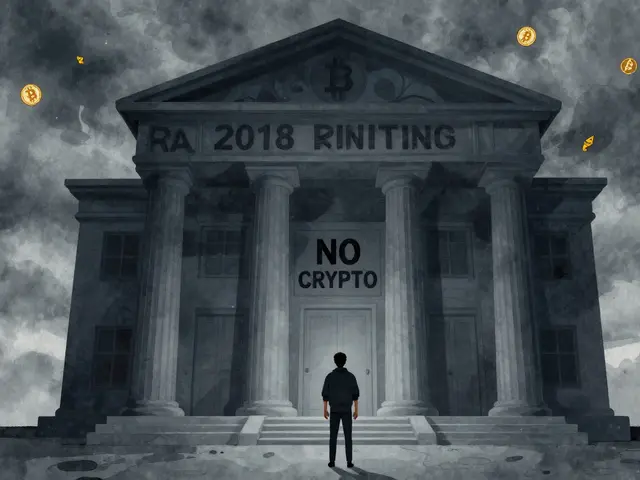Green Crypto Energy Calculator
Calculate how much energy your cryptocurrency transactions consume compared to major green networks. The data uses verified metrics from the article and is updated for 2025.
Energy Results
Did you know? Algorand's energy consumption is so low that the entire network uses less power annually than a single household's LED bulbs.
Imagine a world where buying a coffee, paying rent, or moving money across borders doesn’t add a carbon footprint the size of a small country. That vision hinges on the rise of environmentally friendly cryptocurrency, a sector that’s already reshaping how we think about digital money.
What makes a crypto "green"?
At its core, a green crypto swaps energy‑hungry mining for consensus mechanisms that need far less power. The most common shift is from proof‑of‑work (PoW) to proof‑of‑stake (PoS). PoS lets holders validate transactions based on the amount of token they lock up, cutting energy use by over 99%.
Proof of Stake a consensus algorithm where validators are chosen based on the size of their stake rather than computational work is now the default for new blockchains. Other eco‑friendly designs include proof‑of‑space‑and‑time, hashgraph, and directed acyclic graphs (DAGs), each offering a different trade‑off between speed, decentralization, and energy use.
Current eco‑crypto landscape
By mid‑2025, three projects dominate the green space:
- Algorand a pure PoS blockchain that consumes just 0.000008 kWh per transaction
- Hedera Hashgraph a hashgraph‑based network with 10,000 TPS and 0.00014 kWh per transaction
- Chia Network a proof‑of‑space‑and‑time platform that uses idle storage instead of ASIC miners
These platforms collectively hold a market cap of $48.7 billion, roughly 8 % of the total crypto market. Their energy metrics are eye‑popping: Algorand’s whole network draws only 0.0006 GWh annually-a fraction of a single data centre.
Energy‑efficiency showdown
| Network | Consensus | kWh/Tx | Annual Energy Use |
|---|---|---|---|
| Bitcoin | Proof‑of‑Work | 1,375 | 115.89 TWh |
| Ethereum (post‑Merge) | Proof‑of‑Stake | 0.01 | 0.01 TWh |
| Algorand | Pure PoS | 0.000008 | 0.0006 GWh |
| Hedera Hashgraph | Hashgraph | 0.00014 | 0.011 GWh |
| Chia Network | Proof‑of‑Space‑Time | 0.023 | 0.35 GWh |
| Cardano | Ouroboros PoS | 0.547 | 0.90 GWh |
| Nano | Block‑Lattice | 0.000112 | 0.001 GWh |
The contrast is stark: Bitcoin’s energy per transaction still dwarfs a small country’s yearly electricity use, while Algorand can settle a payment in under five seconds using less power than a household LED bulb over a day.

Why institutions are hopping on board
Environmental, Social, Governance (ESG) criteria have become gatekeepers for capital. A recent a16z report shows a 64 % YoY rise in stablecoin mentions within SEC filings, signaling that regulators are looking for verifiable green metrics. In the U.S., 92 % of crypto holders say they’d be more likely to invest if a project proved low carbon impact.
Major players are already testing the waters:
- Maersk cut carbon‑verification costs by 37 % using Hedera‑based supply‑chain tracking.
- Several S&P 100 firms hold Algorand or Cardano tokens for treasury diversification.
- Circle’s Cross‑Chain Transfer Protocol reduces integration time for banks from 147 to 28 hours.
Regulators are responding, too. The U.S. GENIUS Act (July 2025) creates a certification framework for “environmentally certified digital assets,” while the European Blockchain Association pushes mandatory efficiency standards.
Regulatory landscape and ESG mandates
Compliance now reads like a checklist:
- Proof of low‑energy consensus (audit‑ready metrics).
- Transparent carbon‑offset reporting, often via on‑chain tokenized credits.
- Lifecycle analysis of hardware to avoid shifting emissions downstream.
Countries differ: the UK’s FCA requires a “green‑wash” audit, whereas Singapore focuses on interoperability with existing climate‑reporting frameworks. This fragmentation is the biggest risk flag for global projects.

Future outlook: what’s next?
Three trends will shape the next decade:
- Carbon Removal Integration Protocol Algorand’s 2025 feature that auto‑purchases carbon credits for high‑impact transactions will become standard, turning every payment into a climate action.
- IAEA forecasts that 75 % of all blockchain transactions will run on energy‑efficient networks by 2026, pushing the remaining PoW chains into niche roles.
- Gartner predicts mandatory efficiency certifications for all major exchanges by 2030, effectively marginalizing high‑energy assets.
Nevertheless, caution remains. MIT’s Simon Johnson warns that hardware lifecycle emissions could offset on‑chain gains. The Environmental Blockchain Audit Consortium found that 31 % of projects labeled “green” failed to meet baseline efficiency thresholds in 2025, highlighting the need for robust third‑party verification.
How everyday users can join the green wave
If you’re curious but overwhelmed, start with these simple steps:
- Choose a wallet that displays real‑time carbon metrics (Algorand’s official wallet does).
- Prioritize networks with pure PoS or DAG consensus - they’re the cheapest on energy bills.
- Consider offsetting high‑impact moves with tokenized carbon credits like SolarCoin.
- Stay informed about certifications - look for the “environmentally certified” badge introduced by the GENIUS Act.
Most users need about eight hours of learning to feel comfortable, according to Kraken’s 2025 data. Community forums on Reddit’s r/GreenCrypto and Discord channels are great places for quick tips.
What is the biggest energy saver in crypto today?
Pure proof‑of‑stake networks like Algorand use less than one‑millionth of the energy Bitcoin needs per transaction, making them the clear winner for low carbon impact.
Can I verify a crypto’s carbon footprint myself?
Yes. Many eco‑friendly wallets show on‑chain metrics, and third‑party auditors publish reports that you can cross‑check with blockchain explorers.
Are green cryptos safe to invest in?
Security varies by project. Algorand and Cardano have strong validator pools, while newer DAG‑based chains may have smaller communities. Always assess both security and sustainability.
How do regulations affect green crypto adoption?
Regulations like the GENIUS Act create certification standards, which make it easier for institutions to adopt green tokens. However, differing rules across regions can create compliance headaches for global projects.
Will Bitcoin ever become green?
Efforts like layer‑2 solutions and renewable‑powered mining pools reduce impact, but Bitcoin’s fundamental PoW design remains far more energy‑intensive than PoS alternatives.







Chris Houser
October 25, 2025 AT 09:46Hey folks, great rundown on the green crypto landscape! The shift from PoW to PoS is the real game‑changer because it slashes the energy bill by over 99 %. If you’re looking to dip your toes in, start by checking the validator uptime stats – they’re a quick proxy for network health. Algorand’s 0.000008 kWh per tx is basically the power draw of a night‑light, so it’s a solid entry point. Keep an eye on wallets that surface on‑chain carbon metrics, they’ll help you stay transparent. Remember, the more you stake, the more you help secure the network while keeping the planet happy.
William Burns
October 26, 2025 AT 07:59The discourse surrounding environmentally sustainable digital assets necessitates a rigorously analytical framework. One must first delineate the ontological distinction between proof‑of‑work and proof‑of‑stake paradigms. Proof‑of‑work, predicated upon computationally intensive hash functions, intrinsically incurs a prodigious quantum of electrical consumption. Conversely, proof‑of‑stake leverages capital commitment as a stochastic validator selection mechanism, thereby effecting a substantial diminution of energy requisites. Empirical data presented herein, notably the comparative tabulation of kilowatt‑hours per transaction, incontrovertibly corroborates the superiority of pure PoS architectures. Algorand’s consumption of 0.000008 kWh per transaction is tantamount to the energy expended by a single LED bulb over an interval of 15 seconds. Such metrics are not merely anecdotal but constitute a cardinal criterion for institutional ESG compliance. The emergent regulatory instruments, exemplified by the U.S. GENIUS Act, instantiate a codified certification schema predicated upon verifiable carbon footprints. This legislative development inexorably catalyzes the capital allocation preferences of fiduciary entities towards low‑carbon protocols. Moreover, the confluence of corporate adoption-manifested by enterprises such as Maersk integrating Hedera for supply‑chain verification-augments the legitimacy of these networks. Nevertheless, one must exercise circumspection regarding the lifecycle emissions associated with hardware production, a variable oft‑overlooked in superficial analyses. The Environmental Blockchain Audit Consortium’s 2025 audit, which identified a 31 % non‑conformity rate among self‑designated “green” projects, underscores the exigency of third‑party oversight. Future trajectories envisage the integration of carbon‑removal protocols, whereby token transactions automatically subsidize offset initiatives. In sum, the inexorable migration towards energy‑efficient consensus mechanisms constitutes an inflection point in the evolution of decentralized finance. Stakeholders who eschew this transition risk obsolescence in an increasingly climate‑conscious financial marketplace.
Ashley Cecil
October 27, 2025 AT 06:12It is incumbent upon investors to scrutinize both security and sustainability metrics before allocating capital.
Mike Kimberly
October 28, 2025 AT 04:26Building upon the meticulous exposition offered earlier, it is worth emphasizing that the juxtaposition of energy efficiency and network decentralization is not a zero‑sum game. While pure PoS systems exhibit exemplary low‑energy footprints, they must also maintain a sufficiently diverse validator set to avoid centralization pressures. The academic literature on staking dynamics suggests that threshold staking requirements can inadvertently marginalize smaller participants, thus necessitating thoughtful parameter tuning. From a pragmatic standpoint, developers should incorporate slashing mechanisms that penalize malicious behavior without deterring modest stakeholders. Ultimately, the reconciliation of ecological imperatives with robust security remains the sine qua non of a resilient green blockchain ecosystem.
angela sastre
October 29, 2025 AT 02:39Totally agree, and to add a quick tip – most mobile wallets now have a “green mode” toggle that shows the estimated carbon cost per transfer. If you enable that, you’ll see the exact kWh number right before you hit send, which makes budgeting your environmental impact as easy as checking the gas fee. Also, consider using custodial services that aggregate staking for you; they often achieve better economies of scale while still reporting transparent on‑chain metrics. Lastly, don’t forget to claim any carbon‑offset rewards that platforms like Algorand occasionally airdrop to active users – they’re essentially free climate credits.
Claymore girl Claymoreanime
October 30, 2025 AT 00:52While the previous analysis is undeniably comprehensive, it suffers from an overly academic veneer that obfuscates practical considerations. The average retail participant does not have the luxury of dissecting validator set diversity or slashing algorithmic nuances. Moreover, the insistence on pure PoS as the panacea ignores hybrid models that blend PoS with Byzantine fault tolerance for enhanced security. In short, the discourse would benefit from grounding its theoretical rigor in everyday user experience.
Laura Herrelop
October 30, 2025 AT 23:06When one contemplates the audacious ambition of branding crypto as “green,” it is impossible not to detect the subtle choreography of power structures seeking legitimacy. The narrative of carbon‑neutral blockchains serves as a veneer, masking the entrenched interests of the tech elite who profit from the very hardware supply chain they claim to eschew. This paradox elicits a deeper inquiry into whether transparency metrics are genuinely public or merely curated datasets presented to appease regulators. If the latter holds true, then the proclaimed sustainability becomes a strategic illusion designed to co‑opt ESG momentum.
Nisha Sharmal
October 31, 2025 AT 21:19Oh, please – the whole “big‑tech conspiracy” spiel is as tired as a stale meme on a forgotten forum. Green crypto? It’s simply the natural evolution of blockchain technology, and anyone refusing to see that is living in the past. Stop romanticizing the “old ways” and get with the program.
olufunmi ajibade
November 1, 2025 AT 19:32Let’s cut through the rhetoric and focus on the data: Algorand’s network draws less energy than a single household refrigerator per day, which is a concrete fact you can verify on their explorer. If you’re skeptical, dive into the open‑source validator logs – they’re publicly available and show real‑time carbon metrics. The point isn’t to vilify any nation or corporation but to celebrate technologies that actually reduce emissions.
Cyndy Mcquiston
November 2, 2025 AT 17:46Green crypto is the future if we all adopt it.
Natasha Nelson
November 3, 2025 AT 15:59Hey everyone! !!! I’m pumped about the shift to low‑energy networks!!! It’s amazing how a tiny stake can power a global transaction while keeping the planet happy!!! Keep exploring, keep staking, and let’s make crypto truly green!!!
Anastasia Alamanou
November 4, 2025 AT 14:12Indeed, the proliferation of zero‑knowledge rollups on PoS chains further amplifies throughput while preserving cryptographic integrity, thereby reinforcing the sustainability narrative you highlighted. By integrating such layer‑2 solutions, users can achieve sub‑second finality with negligible marginal energy expenditure, a development poised to accelerate mainstream adoption. Your enthusiasm is well‑placed, as the confluence of technical innovation and environmental stewardship heralds a paradigm shift in digital finance.
John Dixon
November 5, 2025 AT 12:26Wow, what an optimistic manifesto – as if waving a selfie stick will solve the climate crisis!!! Sure, let’s ignore the fact that even PoS validators consume electricity and that hardware manufacturing still emits CO₂!!! Maybe next we’ll sprinkle unicorn emojis on every carbon report!!!
Brody Dixon
November 6, 2025 AT 10:39I hear your frustration, and it’s completely valid to question the hype when the underlying processes still have an environmental footprint. At the same time, recognizing incremental improvements doesn’t diminish the urgency of broader systemic change. By staying informed and demanding transparent audits, we can collectively push the industry toward genuine sustainability without dismissing the progress already made.